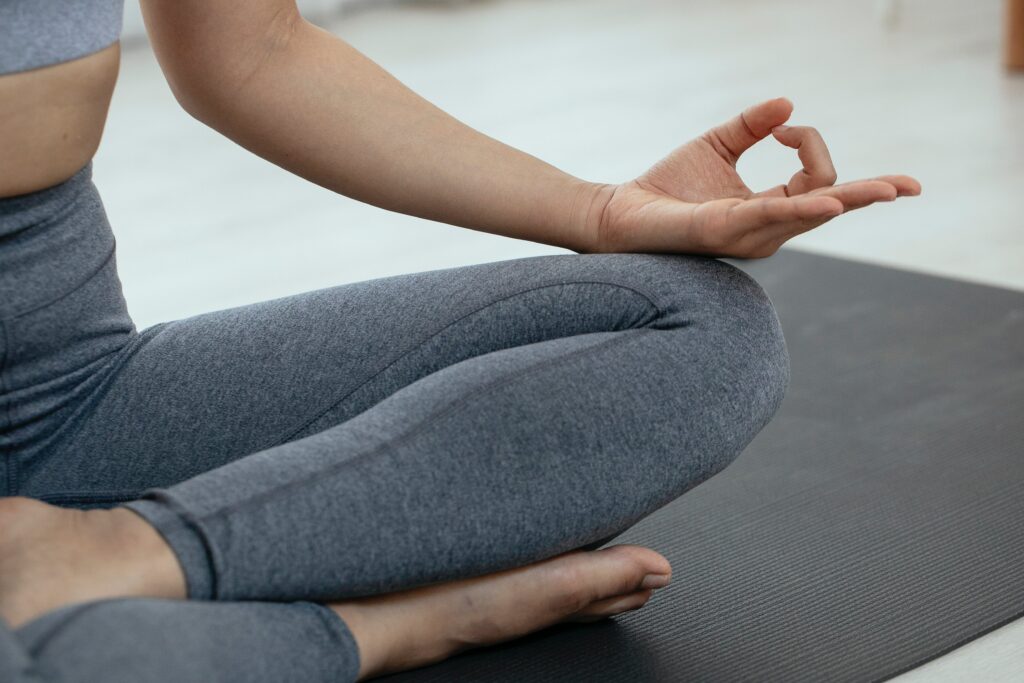
Aparigraha and The Art of Letting Go
Aparigraha: Non-Attachment
Aparigraha, is the fifth yama and encompasses the art of letting go. The Yamas form a sort of moral code, and the eight limbs of yoga really show how yoga goes far beyond poses and the mat. These moral codes form guidelines by which to live with regard to our relationship with ourselves, and the world around us. These moral codes can be applied both on an off the yoga mat, helping us to practise not just for the benefit of ourselves, but also the world around us.
Patanjali’s yamas are:
Ahimsa: Non-Violence or Kindness
Satya: Truthfulness
Asteya: ‘Non-Stealing’ or living through Abundance
Brahmacharya: Right use of energy
Aparigraha
Last but by no means least is Aparigraha. This important yama teaches us to take only what we need, keep only what serves us in the moment, and to let go when the time is right.
It is the nature of things to change and by failing to let them change or by failing to go with the flow, we begin to feel discontent and disappointment. However what we try to possess, possess us. Aparigraha asks us to trust life like we trust the breath. Can we take in all the nourishment of the present moment and then fully let it go, trusting that more nourishment will come? Relationships, homes, food, routines that bring a sense of ease are all forms of nourishment until we unconsciously get attached to them and thoughts of criticisms, opinions, and judgments, and disappointments can sink in. We forget to trust life, to trust the exhale, and let go.
Aparigraha is the last Yama in Patanjali’s Eight Limbs of Yoga. It often translates to non-possessiveness, non- attachment, or ‘non-grasping’ and within its essence lies the key to unlocking a life of greater freedom and inner peace.
This is probably the one Yama that has influenced me the most and how I think and approach things. We can apply this in so many ways. We often find ourselves entangled in a web of desires. We chase possessions, crave validation, and cling to outcomes. This grasping, however, creates a sense of lack, a constant yearning that leaves us feeling unfulfilled. Aparigraha invites us to loosen our grip, to step off the treadmill of “more.”
Instead of chasing external validation, Aparigraha encourages us to cultivate inner contentment. It’s about discovering the joy that already exists within, the wellspring of happiness independent of external circumstances. This doesn’t mean indifference, it means appreciating what we have while remaining open to life’s unfolding.
‘Let your concern be with the action alone, and never with the fruits of action. Do not let the results of your action be your motive, and do not be attached to inaction’Krishna (The Bhagavad Gita)
Aparigraha on the Mat
We often step onto our yoga mats brimming with anticipation for the practice, setting our goals, and prepared to flow our bodies and breathe towards a calmer state of mind. Yet, frequently in the midst of the session, a shift occurs. We lose touch with the true purpose of our arrival, and our practice transforms from a journey of self-discovery and present awareness into a silent contest with the neighbour on our mat, or a relentless pursuit of that visually stunning pose.
This is precisely where the concept of Aparigraha comes into play.
Aparigraha in yoga isn’t about indifference or disinterest. It’s about releasing rigid expectations, for ourselves and the pose itself. It’s about focusing on the present experience, the rhythm of our breath, and the sensations arising within our bodies. It’s about cherishing the process, not just the final destination of achieving a perfectly aligned headstand.
You can use Aparigraha on the mat by releasing expectation of your physical asana practice and just enjoying it. When I’m focused on my breath, when I move for the love of it, my practice flows so much more freely and I move more intuitively. When I’m present, relaxed and connected to my breath, sometimes I can do a forearm balance, but if I don’t, I don’t. Sometimes my body and mind say ‘no, not today!’ Those days are usually reserved for lovely gentle stretches and legs up the wall.
Practice for the Love of Practising
While advancements in our practice are certainly motivating, they shouldn’t be the sole source of gratification. The inherent delight of the practice itself is the most significant reward. It’s about discovering the liberation that comes from letting go of rigid goals and simply moving our bodies in a way that brings us comfort. When we practice for the pure enjoyment of it, without exerting force or exceeding our limits, the body will naturally blossom, and those seemingly difficult asanas will become attainable before we know it.
Aparigraha in our Minds
The power of hindsight is undeniable, yet frustratingly helpful. Wouldn’t it be amazing to know in advance that the things that plague us with worry are ultimately inconsequential? Wouldn’t it be liberating to shed the anxieties of “what if” and simply savour the present moment and focus on “what is”?
Every time we embark on a new relationship, encounter a surge of joy and contentment, or initiate a fresh endeavour, a flicker of apprehension often arises as we contemplate, even fleetingly, the inevitable conclusion: what happens when this ends?
It’s perfectly natural to become attached to positive emotions and experiences. After all, who wouldn’t want to extend happiness for as long as possible? But when we encounter positivity, do we truly allow ourselves to immerse ourselves fully in the experience, or do we grasp onto it desperately, wishing everything would remain exactly as it is in that fleeting moment?
Parinamavada – being in flux
The Sanskrit concept of Parinamavada teaches us that everything is in a state of perpetual transformation. Change, indeed, is the only reliable aspect of life. Just as trees shed their leaves in autumn to pave the way for new buds in spring, day gives way to night, and seasons come and go in a cyclical dance, so too do we experience constant change, every moment of every day. Our physical bodies are in a state of perpetual flux every second, with cells constantly regenerating, blood flowing, bones undergoing wear and tear followed by stimulation for rebuilding, and breath moving in and out of our bodies. Similarly, our minds are constantly experiencing change.
While happiness, joy, and peace are desirable emotions to experience, emotions like sadness, anger, and loss are equally important. To experience only the positive aspects of life is to experience only a fraction of what life offers. Life presents us with the opportunity to experience and learn from every aspect of our being, both the light and the darkness. To truly live, we must not resist the experiences we don’t desire, but allow them to unfold, knowing that even these will eventually pass. When we allow the moment to be what it is, without clinging to it or pushing it away, we can truly say we are living in that moment, allowing experiences to come and go, without the need to grasp onto any of them.
How to implement Aparigraha into our Lives
So, how do we cultivate Aparigraha in our daily lives? Here are a few practices to consider:
Gratitude Practice: Take time each day to appreciate the things you already have, both big and small. A grateful heart is a heart less prone to grasping.
Simplify: Declutter your physical and mental space. Get rid of possessions that no longer serve you, and release yourself from the burden of excess.
Focus on Experiences: Instead of accumulating more stuff, invest in experiences that create memories and enrich your life.
Let Go of Expectations: Release the need to control outcomes. Embrace the present moment and trust that life will unfold as it should.
Aparigraha Affirmations: Cultivating Non-Attachment
Here are some affirmations to support your practice of Aparigraha:
Inner Contentment:
- I am overflowing with inner joy and contentment.
- My happiness comes from within, not from external possessions.
- I am grateful for all that I have, and open to what life brings.
Letting Go:
- I release the need to control and the fear of loss.
- I detach from outcomes and embrace the present moment.
- I loosen my grip on material possessions and find freedom in simplicity.
Experiences over Possessions:
- I choose experiences that enrich my life over acquiring more stuff.
- I value memories and connections over material possessions.
- My life is filled with adventures and meaningful experiences.
- My worth is not defined by what I have.
Acceptance and Trust:
- I accept the impermanent nature of life and embrace change.
- I trust the flow of life and release the need to hold on.
- I am open to receiving what I truly need, when I need it.
- I am open to abundance flowing into my life.
Practices for Aparigraha:
- Let it go! Practice non-attachment in areas of your life where there is too much attachment or reliance.
- Fully enjoy each thing without needing it to repeat itself.
- Live with curiosity and intention, not expectations.
- What expectations have you placed on friendships, relationships, or other people?
- Let go of control and be willing to be surprised.
- Practice generosity and trust.
Journal Prompts for Aparigraha
Material Possessions
- What possessions or material things bring me genuine joy and serve a purpose?
- What items do I hold onto out of guilt, obligation, or a fear of missing out?
- Could I simplify my life by decluttering physical space?
Beyond the Physical
- Do I hold onto negative emotions or experiences? How can I practice letting go?
- Am I attached to specific outcomes or results? How can I cultivate a sense of detachment?
- Do I cling to unhealthy relationships or situations? How can I practice Aparigraha in my interactions?
Gratitude and Abundance
- What are some things I’m grateful for that don’t require material possessions?
- How can I cultivate a sense of abundance without needing more “stuff”?
- How can I appreciate the present moment more, instead of yearning for what I lack?
Taking Action
- Is there a specific area where I can start practicing Aparigraha today? (e.g., decluttering, letting go of a grudge)
- How can I incorporate Aparigraha principles into my everyday routine?
- What are some sustainable practices I can adopt to reduce my need to acquire more?
Aparigraha Offers us so Much Freedom.
It grants us the freedom to pursue our passions and work that ignites our souls, unburdened by anxieties about the final outcome. It grants us the freedom to rely less on external validation and material possessions as a source of happiness. Ultimately, it grants us the freedom to experience life’s full spectrum of offerings, whatever shape they may take. Imagine the possibilities that unfold when you integrate this principle into your life. Imagine what happens when you simply release your grip and allow things to be and just let go.
I think the biggest learning for me was trying to live in a less emotionally attached way. We can’t control other people or the way the day goes sometimes, but we can gain control of how we respond; over how we learn and move forwards. In essence, moving more towards acceptance than expectation. This I feel, will be life long work but for me it’s removed an awful lot of stress and worry.
Connect, breath and flow rather than expect your yoga practice to be a linear experience that always improves. We can do the same off the mat too.
If you’d like more information on anything yoga please contact me or book here to practise with me in Marlow, Twickenham and online.
With love
Anney xx




